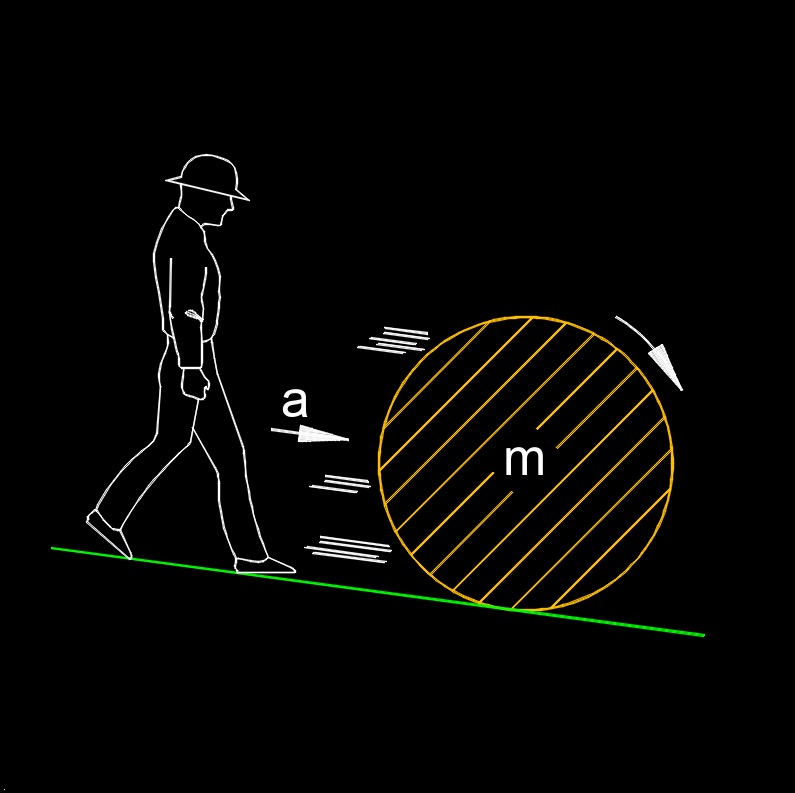Constant Acceleration
 Constant acceleration, abbreviated as \(a_c\), is used in physics to describe the motion of an object that is experiencing a uniform change in velocity. The object is either speeding up or slowing down at a constant rate over time. Acceleration is a vector quantity, meaning it has both magnitude and direction. When an object experiences constant acceleration, it means that the magnitude of its acceleration remains the same, and its direction may or may not change.
Constant acceleration, abbreviated as \(a_c\), is used in physics to describe the motion of an object that is experiencing a uniform change in velocity. The object is either speeding up or slowing down at a constant rate over time. Acceleration is a vector quantity, meaning it has both magnitude and direction. When an object experiences constant acceleration, it means that the magnitude of its acceleration remains the same, and its direction may or may not change.
One common example of constant acceleration is an object in free fall near the surface of the Earth. When an object is dropped, it accelerates due to gravity at a rate of approximately 9.8 meters per second squared in the downward direction, assuming air resistance is negligible. This is a classic example of constant acceleration because the acceleration due to gravity remains constant near the Earth's surface.
Constant acceleration is also used in various physics and engineering problems to model the motion of objects subjected to forces, such as cars accelerating and decelerating, projectiles in motion, and many other scenarios where the acceleration is relatively constant over a short time interval.
Constant Acceleration formula |
||
|
\( v = v_i + a \; t \) (Constant Acceleration) \( v_i = v - a \; t \) \( a = v - ( v_i \;/\; t ) \) \( t = v - ( v_i \;/\; a ) \) |
||
| Symbol | English | Metric |
| \( v \) = velocity | \(ft \;/\;sec\) | \(m \;/\;s\) |
| \( v_i \) = initial velocity | \(ft \;/\;sec\) | \(m \;/\;s\) |
| \( a \) = acceleration | \(ft \;/\;sec^2\) | \(m \;/\;s^2\) |
| \( t \) = time | \(sec\) | \(s\) |
Constant Acceleration formula |
||
|
\( d = \frac{1}{2} \;\left(v_i + v \right) \;t \) (Constant Acceleration) \( v_i = ( 2 \; d \;/\; t ) - v \) \( v = ( 2 \; d \;/\; t ) - v_i \) \( t = ( 2 \; d \;/\; v_i ) + v \) |
||
| Symbol | English | Metric |
| \( d \) = displacement | \(ft\) | \(m\) |
| \( v_i \) = initial velocity | \(ft \;/\;sec\) | \(m \;/\;s\) |
| \( v \) = velocity | \(ft \;/\;sec\) | \(m \;/\;s\) |
| \( t \) = time | \(sec\) | \(s\) |
Constant Acceleration formula |
||
|
\( d = v_i \; t + \frac{1}{2} a \;t^2 \) (Constant Acceleration) \( v_i = ( d - \frac{1}{2} \; a \; t^2 ) \;/\; t \) \( t = ( - v_i \; \mp \; \sqrt{ v_i^2 \;+\; 2 \; a \; d } \;\; ) \;/\; a \) \( a = 2 \; d \;/\; t^2 \) |
||
| Symbol | English | Metric |
| \( d \) = displacement | \(ft\) | \(m\) |
| \( v_i \) = initial velocity | \(ft \;/\;sec\) | \(m \;/\;s\) |
| \( t \) = time | \(sec\) | \(s\) |
| \( a \) = acceleration | \(ft \;/\;sec^2\) | \(m \;/\;s^2\) |
Constant Acceleration formula |
||
|
\( d = v \; t - \frac{1}{2} a \;t^2 \) (Constant Acceleration) \( v = ( d + \frac{1}{2} \; a \; t^2 ) \;/\; t \) \(t = ( v \; \mp \; \sqrt{ v^2 \;-\; 2 \; a \; d } \;\; ) \;/\; a \) \( a = v \; \mp \; \sqrt{ v^2 \;-\; 2 \; d } \) |
||
| Symbol | English | Metric |
| \( d \) = displacement | \(ft\) | \(m\) |
| \( v \) = velocity | \(ft \;/\;sec\) | \(m \;/\;s\) |
| \( t \) = time | \(sec\) | \(s\) |
| \( a \) = acceleration | \(ft \;/\;sec^2\) | \(m \;/\;s^2\) |
Constant Acceleration formula |
||
|
\( v = v_i^2 + 2\;a\;d \) (Constant Acceleration) \( v_i = \sqrt{ v - 2\;a\;d } \) \( a = v - v_i^2 \;/\; 2 \; d \) \( d = v - v_i^2 \;/\; 2 \; a \) |
||
| Symbol | English | Metric |
| \( v \) = velocity | \(ft \;/\;sec\) | \(m \;/\;s\) |
| \( v_i \) = initial velocity | \(ft \;/\;sec\) | \(m \;/\;s\) |
| \( a \) = acceleration | \(ft \;/\;sec^2\) | \(m \;/\;s^2\) |
| \( d \) = displacement | \(ft\) | \(ft\) |

Tags: Acceleration

